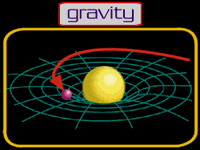
|
- General Theory of Relativity
-
The Theory of General Relativity was developed by Swiss physicist Albert Einstein in 1915. In Einstein's
theory, time is treated as an extra dimension in addition to the three spatial dimensions -- height, width and
depth. Thus matter moves not only in space, but also in time. Nobody can stop time from ticking away,
right? So even when an object remains still in space, it still moves along in time.
Matter is always moving in space-time. However, in order to save energy, it always seeks the shortest
path to travel. Meanwhile, matter also bends space-time. If there were no matter in the universe,
space-time would be flat. The relation between matter and space-time is very complicated and is what
the general theory of relativity tries to solve.
It is the interplay between matter and space-time that leads to gravity. To understand this, let's look at the
following analogy. Suppose a particle wanders around the universe. If there is no object nearby, then
space-time is flat and the particle will travel in a straight line because it is the shortest route. However, if
the particle passes by another particle, the two particles will roll into each other because each particle is
moving in a curved space-time bent by the other. The two particles appear to be pulled together by
gravitation. This is how gravity works. Thus, the theory of general relativity is in fact the theory of
gravitation.
|


Fig.1 Space-time curved by a massive ball. A tiny ball that wanders nearby "falls" into the center
due to the curvature created by the massive ball. The tiny ball also bends space-time, but the curvature
is negligible compared to that made by the massive ball. Gravity works in a similar way.
|

Fig.2 Lack of gravity is what enables this astronaut to "fly" through space.
Figure Credits:
Fig.1 Z. H. Zhou; Fig.2 NASA.
|
- The Dominant Force
-
Although the other three fundamental forces play vital roles in a star, they are irrelevant when it comes to
the scale of galaxies. This is because weak and strong nuclear forces are only short range forces. Their
influence does not go beyond the nuclei of atoms. Electromagnetic force is a long range force like gravity.
However, unlike gravity, it not only attracts but also repels depending on what charges are
involved.
There are two kind of charges: positive and negative. Particles with the same charges repel each other;
those with opposite charges attract. Our universe seems to have an equal amount of positive and
negative charges. Therefore, the attracting and repelling forces cancel each other out when they are
spread out over a sufficiently large scale. The only force left to dominate the galaxies is thus gravity --
even though it is the weakest force. Gravity acts like an organizer that puts stars, galaxies, and clusters in
order.
|